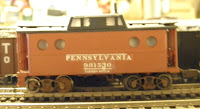 |
| PRR Class N5c Cabin Car |
 |
| PRR Class N5 Cabin Car |
The only way to get these singular looking cars without scratch building is to bite the bullet and shell out the money. Since I won't be purchasing a hundred or so I can accept that. They usually go for about $25 each, but I have gotten them a tad cheaper through careful shopping.
The problem with building up the rest of my Pennsy freight car fleet the "correct" way is availability and cost. The models of PRR equipment that are on the market tend to be on the pricey side. While it might be OK to spend $15 on a few Bowser hoppers, to me it's downright insane to buy these models in any great quantity. If you have a budget, you cannot afford a lengthy train of such models (unless you buy 'em over a number of years). The typical Allegheny Eastern coal drag is short by some standards, perhaps twenty - thirty cars. Such a train would cost anywhere between $300 to $450. This does not include the 4 diesel lash-up at the head end and the cabin at the rear. That's just one train!
On the All East there are at least two coal drags on the main at any one time. That's well over $1000 when you toss in the motive power and crummy (caboose in railroadish). There needs to be some way to cut the cost. Fortunately there may be.
Many of the hoppers will be the shorter GL class and its variants. These cars are considered gondolas in the PRR classification system. Go figure. These are two bay cars with a capacity of 50 tons. I feel that these cars can be represented by "generic" 50 ton hoppers painted and lettered for the PRR. These other cars are often available on E-Bay and at train shows. Often you can buy a slew of them for what you might pay for one GLa model. The generic cars can also be used to model the H31 class with composite cars being used as the H31a and H31b. If you add diagonal braces you can also represent the H31c
 |
| "Generic" 50 Ton Hopper |
 |
| Bowser GLa 50 Ton Hopper |
 |
| Bowser H21a 70 Ton Hpper |
| "Generic" 4 Bay Hopper |
I thought many of the hopper cars currently on the layout might be just downright wrong. There are a lot of three bay hoppers and I wasn't sure the Pennsy owned any. By studying the equipment diagrams at prr.railfan.net I found that the H37 and H39 classes were three bay 70 ton. While the cars I have may be 100 ton, I can live with that.
 |
| PRR Class H39 70 Ton Hopper |
 |
| Current 3 Bay Hopper in the Fleet |
Covered hoppers are pretty easy. For the most part bulk commodities like grain were hauled in boxcars in the 40's. Some materials, like carbon black used in manufacturing automobile tires, were shipped in this type of hopper. I have a couple and they are already lettered for carbon black service.
Pennsy boxcars are another type that can be rather unique. One in particular is the class X31 "wagon top" although the Baltimore & Ohio also had a version (even wagon top cabeese). Models of these cars are produced by several companies, including Micro Trains. Once again, I'm only buying a few.so they fit in the budget. The PRR's "standard" boxcars were the X29 and its variations. Aside from the actual X29, many of the other X class variants resemble their contemporaries on other roads. The X25c can be represented by any other USRA single sheathed boxcar.
Many of the other classes can be modeled using similar generic cars. Flatcars, stockcars and reefers tend to look the same no matter who built them. The PRR had a unique looking steel stockcar but it did not appear till the 1950's. For the most part, if I lay aside any purist tendencies I can make reasonable facsimiles of Pennsy freight cars.
Why all the fussiness if I'm going to paint and letter everything for the All East? Simple, I want the Allegheny Eastern to reflect the Pennsylvania Railroad as much as possible. Keeping it freelance just allows me a little artistic license.
Regards,
Frank Musick
Chief Cook and Bottle Washer
 |
| Allegheny Eastern Railroad |

No comments:
Post a Comment